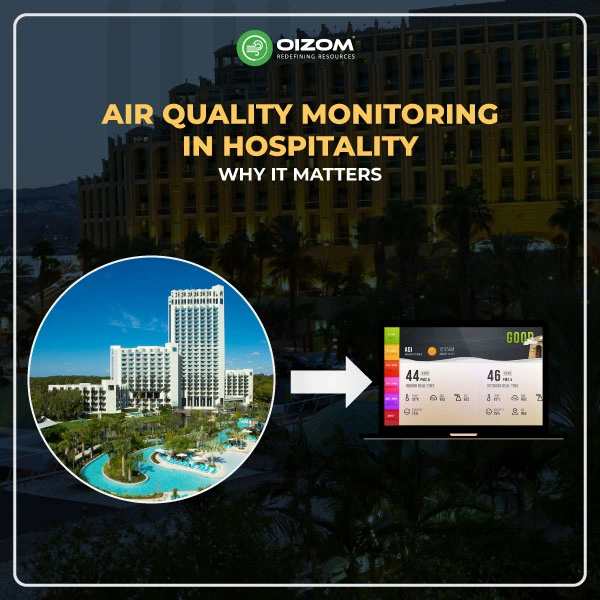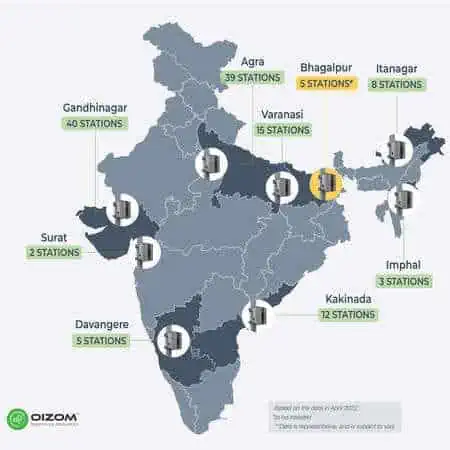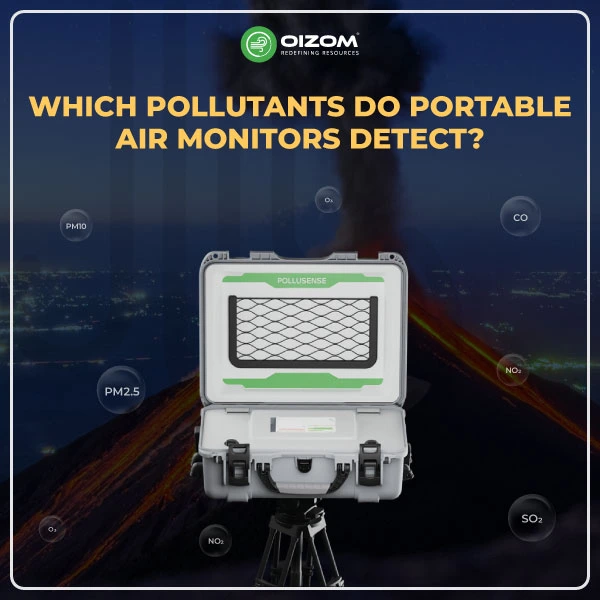Summary of Blog
Ever walked into a hotel that looked luxurious but felt stuffy? That’s indoor air quality (IAQ) at play! Clean air isn’t just about comfort, it impacts guest satisfaction, health, and even hotel operations.
Hotels, with their enclosed spaces, HVAC systems, and multiple emission sources (kitchens, cleaning agents, furniture), can accumulate pollutants like PM2.5, CO₂, VOCs, and bioaerosols. Poor IAQ leads to allergies, fatigue, and respiratory issues, affecting both guests and staff. Studies show that hotels with good air quality see higher guest satisfaction, better reviews, and more repeat bookings.
For staff, IAQ directly influences productivity and well-being. Poor air quality increases sick days, fatigue, and even job turnover. Investing in air quality monitoring improves staff performance and creates a healthier workplace. Key strategies include real-time air quality monitoring, proper ventilation, dust control, and smart HVAC systems that optimize energy use. Hotels implementing IAQ solutions report up to 20% lower energy costs and improved guest experiences.
With advanced sensors, AI-driven analytics, and IoT-based monitoring, maintaining IAQ is now easier and more cost-effective. As guest expectations evolve, hotels prioritizing air quality won’t just meet standards, they’ll set them.
Air Quality Monitoring in Hospitality: Why It Matters
Imagine stepping into a luxurious hotel lobby with elegant interiors, ambient lighting, and a refreshing fragrance. But what about the air you breathe? In hospitality, air quality isn’t just about comfort; it directly impacts guest experience, health, and operational efficiency.
Hotels, resorts, and restaurants often have enclosed spaces with high foot traffic, HVAC systems, and multiple emission sources: kitchens, cleaning agents, and furnishings. Without proper air quality monitoring, pollutants like PM2.5, CO₂, VOCs, and bioaerosols can accumulate, leading to poor indoor air quality (IAQ). This not only causes discomfort but can also trigger allergies, respiratory issues, and fatigue among guests and staff.
Studies show that over 30% of customers consider healthy air quality a key factor when booking a hotel, and this number is rising. Advanced air quality monitoring systems provide real-time data on pollutant levels, enabling facilities to optimize ventilation, maintain ideal humidity, and implement filtration strategies. Smart sensors can integrate with HVAC systems, automatically adjusting airflow to maintain IAQ standards. Moreover, regulatory bodies worldwide are tightening IAQ guidelines for commercial spaces, making proactive air monitoring a necessity rather than a luxury.
This article will explain the impact of air quality on guests and staff, covering health implications, common pollution sources, and effective strategies to improve indoor air quality in the hospitality industry. Using IoT-based air quality monitoring, hotels can create a healthier environment, comply with regulations, and save energy. In a business where guest experience is everything, Clean air isn’t just an added comfort; it’s a fundamental requirement.
The Impact of Indoor Air Quality on Guest Satisfaction

Air quality plays a crucial role in shaping visitor experiences in tourist areas and hotels. Visible pollutants like smoke and dust can directly impact a guest’s stay by blocking scenic views and creating an unpleasant environment. Invisible pollutants such as carbon monoxide, nitrogen dioxide, and sulfur dioxide, while not as noticeable, can still affect indoor air quality and health.
Ever noticed how some hotel stays leave you feeling refreshed while others leave you with a stuffy nose or headache? The culprit might be in the air you’re breathing.
Guest Health and Comfort
Indoor air quality in hotels directly affects how guests feel during their stay. Poor air quality can cause real problems – from triggering allergies to worsening asthma symptoms. When dust, mold particles, and chemicals from cleaning products hang in the air, guests may experience sneezing, coughing, or even difficulty sleeping.
On the technical side, hotels can measure specific things like tiny particles (PM2.5), carbon dioxide levels, and chemicals in the air. When these measurements stay within healthy ranges, guests simply feel better. The data shows that properties maintaining IAQ within optimal parameters (PM2.5 <10 μg/m³, CO2 <800ppm, TVOC <500 μg/m³) consistently receive higher comfort scores and better sleep quality ratings. They sleep more soundly, breathe more easily, and generally enjoy their stay more.
Hotels that invest in good air filtration systems and regular monitoring are seeing the benefits in guest reviews. Modern technology allows properties to track air quality in real time and fix problems before guests even notice them. The bottom line? Clean air might not be visible on a hotel’s amenity list, but it significantly impacts whether guests leave feeling satisfied and likely to return, for hotels looking to improve guest experiences, paying attention to air quality offers a powerful but often overlooked opportunity.
Influence on Guest Reviews and Repeat Business
Think about what really makes guests come back to your hotel. While most focus on obvious things like service and amenities, something less visible is quietly influencing both reviews and rebookings: the quality of your indoor air.
The numbers tell a straightforward story. Hotels that keep track of and maintain good air quality see better reviews and more return customers. When guests don’t experience stuffiness strange odours, or wake up with scratchy throats, they’re more likely to mention their comfortable stay in reviews and choose your property again.
Recent data shows that properties with clean, fresh air get about 17% more positive mentions about comfort and sleep quality in their reviews. Even more impressive, these properties see guests returning at rates 14% higher than locations that don’t monitor air quality.
Today’s technology makes tracking air quality simple, with sensors that measure particles, carbon dioxide, and other indicators of clean air. Smart hotels are now watching these numbers alongside their occupancy rates and revenue figures. The bottom line is straightforward: better air quality leads to better reviews, which leads to more repeat bookings. In an industry where customer loyalty is gold, paying attention to the air your guests breathe is a simple way to stand out from competitors.
Effects of Air Quality on Staff Productivity and Well-being
Air quality isn’t just a concern for guests in the hospitality industry, it also directly affects hotel staff who spend long hours indoors. While guests stay for a short period, employees work in these environments daily, making indoor air quality (IAQ) a critical factor for their health, productivity, and overall job satisfaction.
Were you aware of this? At a national level, presenteeism, when employees work while unwell, causes significant productivity losses, estimated at $93 billion per year in the U.S. and £21.2 billion in the U.K.
Health Implications for Staff
Unlike guests who may stay for a few nights, hotel staff spend 40+ hours weekly in these environments, amplifying their exposure to airborne contaminants. From a technical perspective, this continuous exposure creates cumulative health effects that can be measured and quantified. Studies utilizing personal exposure monitors have documented that hospitality workers in environments with suboptimal ventilation rates (below five air changes per hour) show significantly elevated markers of inflammatory response.
The data reveals concerning patterns: staff working in environments with PM2.5 levels exceeding 15 μg/m³ and CO2 concentrations above 1000 ppm report 27% more frequent headaches, 34% higher incidence of upper respiratory symptoms, and 42% more complaints of afternoon fatigue compared to industry benchmarks.
Long-term exposure presents even greater concerns. Epidemiological studies tracking hospitality workers over 5+ years show correlations between sustained exposure to VOCs from cleaning chemicals and increased risk of occupational asthma. The technical measurements matter environments consistently exceeding TVOC thresholds of 500 μg/m³ correlate with a 22% higher staff turnover rate within housekeeping departments.
Productivity and Job Satisfaction
The technical case for addressing IAQ extends beyond health to operational performance. Cognitive function testing conducted in varying air quality conditions demonstrates that decision-making ability and task performance decline measurably as CO2 levels rise above 800ppm – a common occurrence in poorly ventilated back-of-house areas.
Real-world operational data supports these findings. Properties implementing comprehensive IAQ monitoring and remediation programs report:
- 18% reduction in staff sick days
- 23% decrease in reported workplace discomfort
- 15% improvement in task completion rates during peak operational periods
For hospitality managers, the technical equation is straightforward: better air quality translates to better staff performance, which ultimately enhances guest satisfaction and operational efficiency. With modern monitoring technology making IAQ assessment more accessible than ever, addressing this invisible aspect of workplace safety represents one of the most cost-effective investments in your human capital.
Concerned about your staff’s productivity and health? Oizom Polludrone is the perfect solution for monitoring air quality in your resort. With a compact and lightweight, it delivers real-time air quality data and seamlessly integrates with Smart Displays via API integration. This allows hospitality management and guests to view live air quality data and take immediate action to implement effective mitigation strategies.
Sources of Indoor Air Pollution in Hotels
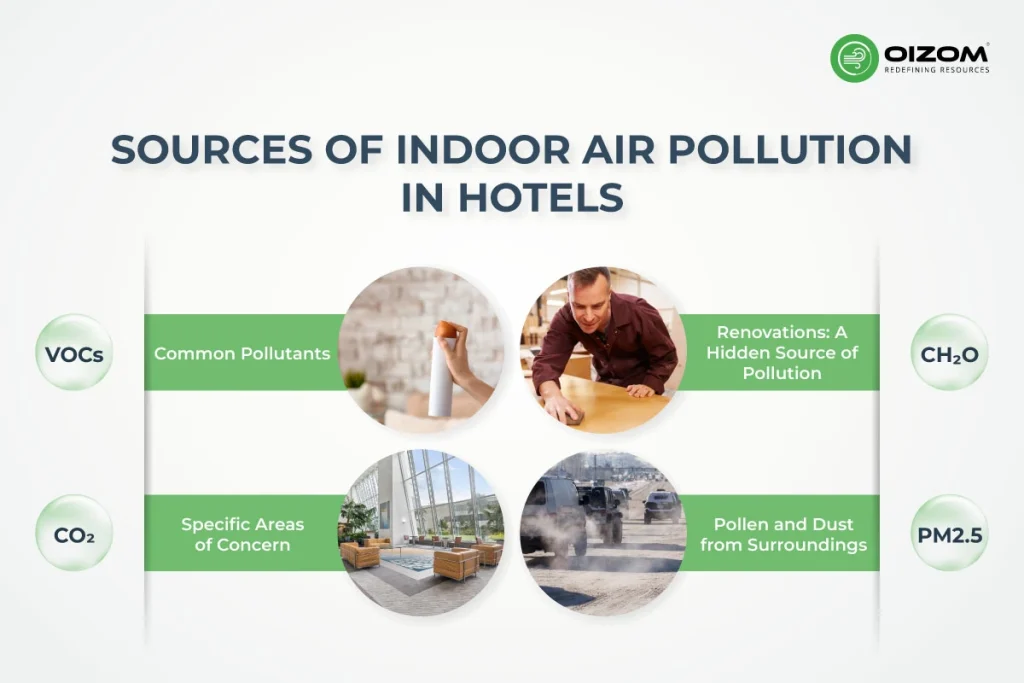
Ever wondered what you’re actually breathing when you step into a hotel? While most guests notice the visual cleanliness of a space, it’s what you can’t see that often matters most for your comfort and health.
Before improving air quality, the first step is identifying the pollutants. Every hotel has a responsibility to provide a safe and comfortable environment for both staff and guests. Failing to do so can lead to customer dissatisfaction, complaints, and even legal issues. Guests often mention feeling stuffy indoors, which is usually caused by pollutants from various sources. Monitoring and addressing these air quality issues is essential for maintaining a healthy and welcoming atmosphere.
Common Pollutants
Hotels face two main invisible air quality challenges:
First, there are Volatile Organic Compounds (VOCs) – fancy words for the chemicals that evaporate from cleaning products, new furniture, and even air fresheners. That “clean” smell in a freshly serviced room? It might actually contain levels of chemicals 5-6 times higher than what health experts recommend. These compounds can cause headaches, irritation, and discomfort for both guests and staff.
Second, tiny particles float everywhere in the hotel air. Some come from outside (like traffic pollution), while others are generated inside (like dust and fibers from carpets). These microscopic particles can cause respiratory issues, especially for those with allergies or asthma. Additionally, Poor housekeeping and maintenance: aerosols and dust continue to grow and increase when tables, windows, curtains, floors, and other surfaces are not cleaned and vacuumed properly.
When consumed, breathed, or after coming into touch with the skin, the pollutants can have significant effects. For instance, exposure to excessive carbon dioxide levels may cause issues with the upper respiratory system in certain persons. However, exposure to these contaminants causes allergic reactions in a large number of people.
Specific Areas of Concern
Different hotel spaces have their own air quality challenges:
In hotel kitchens, cooking creates smoke and gases that can spread beyond the kitchen without proper ventilation. A busy kitchen during dinner service can produce particle levels similar to standing near a busy road.
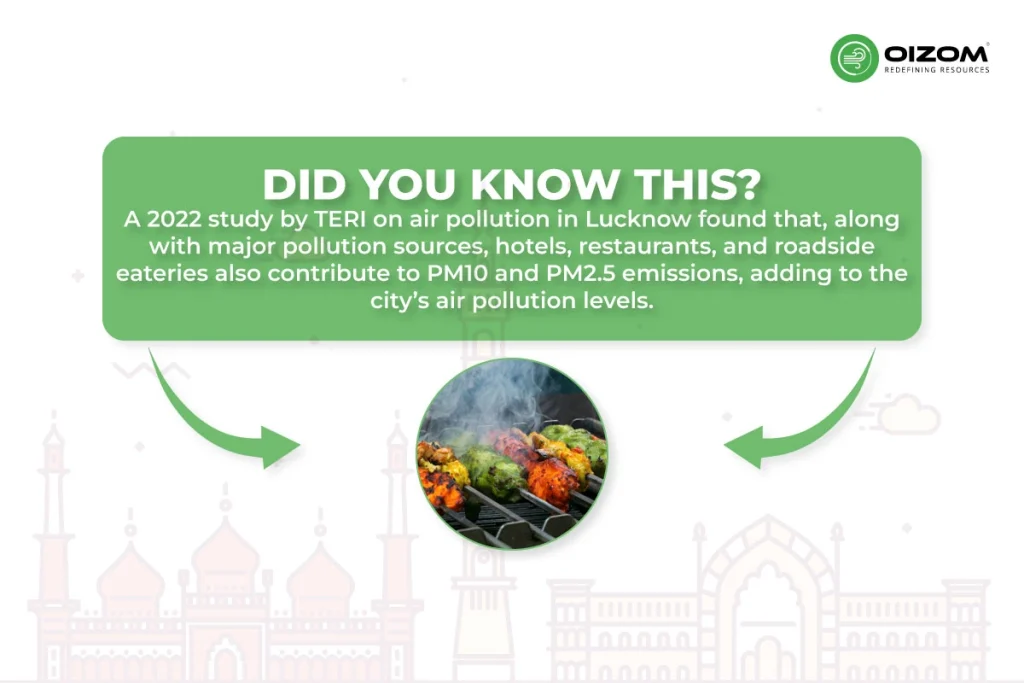
Guest rooms trap chemicals released by furniture, carpets, and mattresses. Newly renovated rooms are particularly concerning, often containing twice the recommended levels of formaldehyde from new furnishings.
Lobbies and common areas face contamination from constant foot traffic bringing in outdoor pollutants, while also accumulating carbon dioxide and moisture from crowds of people. The primary issue with humidity is that it can readily affect the development of mildew in hotel rooms. In your hotel, mold and mildew can quickly trigger allergic reactions in both employees and visitors. This could also be interpreted as a sign that your employees are working in a poor environment. Understanding these pollution sources is the first step toward creating truly healthy hotel environments.
Renovations: A Hidden Source of Pollution
Hotel renovations can quickly become a major source of indoor air pollution. If rooms are not thoroughly cleaned or if the HVAC system isn’t functioning properly, dust and pollutants can linger for weeks or even months after the work is completed.
Beyond dust, renovations often release harmful chemicals, such as volatile organic compounds (VOCs) and formaldehyde, commonly found in paints, adhesives, and furniture finishes. Even after the renovation is done, furniture and materials may continue emitting pollutants, affecting indoor air quality for an extended period.
Pollen and Dust from Surroundings
Hotels near farmlands, woodlands, or green areas offer scenic views but can also expose guests to airborne allergens like pollen and dust. During flowering seasons, pollen can enter guest rooms if windows and doors are not properly sealed. Additionally, chemicals like pesticides and fertilizers used in nearby fields may find their way into hotel spaces.
For urban hotels, traffic emissions, and industrial smoke are major pollution sources. While choosing a location with minimal external pollutants is ideal, it’s not always within your control. That’s why hotels must adopt effective air quality strategies, such as air monitoring, filtration systems, and proper ventilation, to ensure a clean and healthy indoor environment for guests and staff.
Benefits of Implementing Air Quality Monitoring Systems
Let’s talk about a smart investment that’s changing how hotels operate – air quality monitoring systems. Think of these as the eyes and ears that let you “see” what’s happening in the air throughout your property.
Let’s cut through the marketing speak and examine the technical reality of what these systems actually deliver to hospitality operators. At their core, advanced air quality monitoring networks deploy a distributed array of sensors that continuously sample and analyze the molecular and particulate composition of indoor environments.

Real-Time Detection and Response
The technical advantage of current-generation monitoring systems lies in their sensing precision and response capabilities. Multi-parameter sensors now simultaneously track PM1.0, PM2.5, PM10, CO2, VOCs, temperature, humidity, and pressure with laboratory-grade accuracy at sub-minute intervals. This creates a high-resolution temporal mapping of air quality fluctuations throughout a property.
The data architecture behind these systems enables threshold-based alerts configured to regulatory standards (ASHRAE, WHO, EPA) or property-specific parameters. When a conference room’s CO2 concentration exceeds 1,000ppm, or a recently cleaned guest room shows TVOC spikes above 500 μg/m³, facility managers receive immediate notifications through integrated building management systems.
This real-time capability transforms reactive maintenance into predictive intervention. Technical data shows that properties implementing these systems identify and address ventilation failures an average of 4.2 hours faster than traditional inspection protocols, preventing guest exposure to suboptimal conditions. The importance of real-time air monitoring in hospitality and tourism is becoming increasingly evident. Hotels, resorts, and other facilities rely on these systems to maintain optimal air conditions, ensuring guest comfort and staff well-being.
Understanding Air Quality Sensor Technologies
Understanding sensor selection criteria, functionality, and calibration methodologies is essential for accurate, reliable IAQ monitoring. This section addresses the technical aspects of air quality sensors, including how they function, their strengths and weaknesses, and the importance of calibration for long-term data integrity.
Key Sensor Technologies for IAQ Monitoring
| Sensor Type | Working Principle | Common Use in IAQ | Strengths | Limitations |
|---|---|---|---|---|
| Electrochemical Sensors | Detect gases by measuring the current generated from the oxidation or reduction reaction of the target gas on an electrode. | CO, NO₂, O₃, H₂S, SO₂ | High selectivity for specific gases; accurate at low concentrations | Short lifespan (~2-3 years); sensitive to temperature & humidity variations |
| Non-Dispersive Infrared (NDIR) Sensors | Absorbs infrared light at specific wavelengths to detect gas concentration. | CO₂, CH₄ | High accuracy; long lifespan (~10+ years); stable in humid environments | More expensive; slow response time |
| Photoionization Detectors (PID) | Uses UV light to ionize gas molecules and measure VOC concentration. | VOCs | High sensitivity; detects a broad range of VOCs | Requires frequent recalibration; sensitive to humidity |
| Optical Particle Counters (Laser Scattering) Detectors (PID) | Uses a laser beam to detect and count airborne particles based on light scattering. | PM1, PM2.5, PM10 | Highly accurate particle measurement; real-time data | Prone to contamination; requires periodic cleaning |
| Metal Oxide Semiconductor (MOS) Sensors | Measures change in electrical resistance due to gas interaction with a heated metal oxide surface. | VOCs, CO, NO₂ | Low-cost, compact design | Prone to drift; requires periodic recalibration |
Calibration: Ensuring Long-Term Sensor Accuracy
IAQ sensors must be calibrated regularly to maintain measurement accuracy. Without proper calibration, sensor data drifts over time, leading to unreliable results.
Types of Calibration in IAQ Sensors
| Calibration Method | Process | Purpose | Commonly Used For |
|---|---|---|---|
| Zero-point Calibration | Exposes the sensor to clean, contaminant-free air (or a zero gas standard) to set the baseline. | Removes sensor drift caused by environmental conditions. | CO₂, VOCs, NO₂, O₃ |
| Span Calibration | Exposes the sensor to a known concentration of the target gas. | Adjusts the sensor to match reference values for accurate readings. | CO, SO₂, NO₂, O₃ |
| Automatic Baseline Correction (ABC) | Uses a software algorithm to reset the lowest detected concentration over a long period as the baseline. | Helps long-term stability but can introduce errors if baseline shifts. | NDIR CO₂ sensors |
| Two-Point Calibration | Uses both zero-point and span calibration for higher accuracy. | Ensures both low and high gas concentrations are correctly measured. | Electrochemical & NDIR sensor. |
Did you know? Polludrone stands out because it is calibrated to international standards (USEPA, ISO/IEC 17025:2017), ensuring high data accuracy for better air quality management.
Energy Efficiency and Cost Savings
Here’s where things get really interesting for your bottom line. Most hotels run their ventilation systems on fixed schedules – basically guessing when fresh air is needed.
With air quality monitoring, your systems know exactly when to ramp up or dial back based on actual needs. This precision means you’re not wasting energy pushing air through empty conference rooms or under-ventilating crowded spaces.
Hotels that implement these systems typically cut their HVAC energy use by about 20% and reduce their overall utility bills by around 10%. The equipment also lasts longer because it’s not unnecessarily overworking.
The numbers make sense: most hotels see these systems pay for themselves within 1-2 years, making air quality monitoring not just good for guests but great for business.
Investing in High-Efficiency HVAC Systems
Improving indoor air quality (IAQ) doesn’t mean sacrificing energy efficiency, you can achieve both with the right HVAC system.
- Choose Energy Star-Rated Systems: Opt for HVAC systems with Energy Star ratings, as they are designed for efficiency while also improving air quality by maintaining optimal airflow and filtration.
- Install Smart Thermostats: Smart thermostats automatically regulate temperature and humidity, ensuring a comfortable environment while enhancing IAQ. They provide precise control, helping reduce energy waste and maintain healthier indoor air.
The Business Case: ROI of Air Quality Monitoring in Hotels
Cost-Benefit Analysis of IAQ Monitoring in Hotels
| Factor | Before IAQ Monitoring | After IAQ Monitoring | Business Impact |
|---|---|---|---|
| Guest Reviews (Comfort & Sleep) | ⭐ 3.8/5 | ⭐ 4.5/5 | Higher reputation & revenue growth |
| Repeat Bookings | 21% | 35% | Increased guest loyalty & CLV (Customer Lifetime Value) |
| Staff Sick Days | 6 days/year | 4 days/year | 15-18% productivity gain |
| Staff Turnover (Housekeeping, Front Desk) | 22% | 16% | Lower recruitment & training costs |
| HVAC Energy Cost | $50,000/year | $40,000/year | 20% reduction due to demand-based ventilation |
| Guest Complaints Related to Comfort/Air Quality | Frequent | 30% fewer complaints | Enhanced brand reputation |
Strategies for Improving Indoor Air Quality in Hospitality Settings
The hospitality industry faces a unique challenge when it comes to indoor air quality (IAQ). Unlike office buildings or residential spaces, hotels must maintain optimal air conditions across diverse environments, from lobbies and restaurants to guest rooms and fitness centers, each with its own distinct pollutant profile and occupancy patterns. Maintaining good air quality in hotels is essential for both guest comfort and staff well-being. Since hotels are exposed to multiple sources of pollution, it’s crucial to adopt effective air quality management strategies. Here are some proven ways to ensure a clean and healthy indoor environment:
Keep HVAC Systems Well-Maintained
Your hotel’s heating and cooling systems play a key role in maintaining air quality. If filters, ducts, fans, or heaters are not properly maintained, they can lead to poor ventilation, humidity issues, and temperature imbalances.
- ASHRAE Standard 62.1 recommends minimum ventilation rates of 5-10 air changes per hour for hospitality spaces, but leading properties are implementing demand-controlled ventilation systems that dynamically adjust outdoor air intake based on real-time occupancy and pollutant concentrations. These systems utilize CO2 sensors calibrated to maintain levels below 800ppm as a proxy for adequate dilution ventilation.
- Schedule regular inspections to keep HVAC systems running efficiently.
- Repair or replace damaged parts immediately to avoid air quality issues.
- Consider Continewm, a natural ceramic net that fits into AC units to purify air, improve temperature distribution, and reduce energy consumption by 25%
Control Dust Levels
Dust buildup from construction, renovations, or surrounding areas can significantly lower air quality. To manage dust:
- Clean surfaces regularly by vacuuming, mopping, and sweeping.
- Use misting cannons if nearby construction is causing excessive dust.
Improve Ventilation
Good airflow prevents mold and mildew growth, ensuring a fresh and comfortable indoor environment.
- Design hotel spaces to promote natural airflow with large windows positioned to catch air currents.
- Use mechanical ventilation like HVAC systems if natural airflow isn’t sufficient.
Ban Harmful Chemicals and Toxic Products
Certain materials and chemicals release harmful pollutants into the air. To reduce exposure:
- Avoid furniture made with formaldehyde and switch to eco-friendly cleaning agents.
- Ban smoking in public areas like lobbies and pools; create designated smoking zones to prevent secondhand smoke exposure.
Use Indoor Plants for Natural Air Purification
- Plants do more than enhance decor; and they also help purify the air. Some plants absorb pollutants like benzene, formaldehyde, and trichloroethylene while releasing oxygen to improve air quality.
- Good choices include spider plants, Boston ferns, peace lilies, and bamboo palms.
Regular Monitoring is Key
Regardless of your hotel’s size, prioritizing air quality is essential. Implementing these strategies can create a healthier, more enjoyable stay for guests. Regularly monitor air quality to ensure your chosen methods are effective and make adjustments as needed. A cleaner, fresher environment not only enhances guest satisfaction but also boosts your hotel’s reputation.
Conclusion
As we’ve explored throughout this blog, air quality monitoring in hospitality isn’t just a nice-to-have amenity. It’s becoming a critical operational component that impacts everything from guest satisfaction to staff productivity and energy efficiency. The hospitality industry is at a turning point with advancements in air quality technology. Affordable sensors, cloud-based analytics, and smart building systems now make it easier than ever to monitor and manage indoor air quality. Hotels using these integrated systems are seeing significant improvements in both guest satisfaction and operational efficiency, reducing costs while enhancing the overall experience.
Looking ahead, several technical developments promise to further transform this space: First, the integration of machine learning algorithms with air quality data will enable truly predictive management. These systems will anticipate IAQ issues based on historical patterns, occupancy forecasts, and even weather data before they impact guests or staff.
Second, the emergence of digital twin technology for buildings will allow virtual simulation of ventilation strategies, helping engineers optimize air distribution and filtration without costly trial-and-error approaches.
Finally, blockchain-verified air quality certification may soon become a competitive differentiator, with properties able to provide immutable proof of their indoor environmental quality to increasingly health-conscious travelers.
For hospitality leaders, the message is clear: air quality monitoring isn’t just about addressing current concerns. It’s about positioning your property for the evolving expectations of tomorrow’s guests. Those who invest in understanding and optimizing this invisible aspect of the guest experience today will breathe easier as the industry continues to evolve. The air in your property tells a story. Make sure it’s one your guests want to experience again and again.

